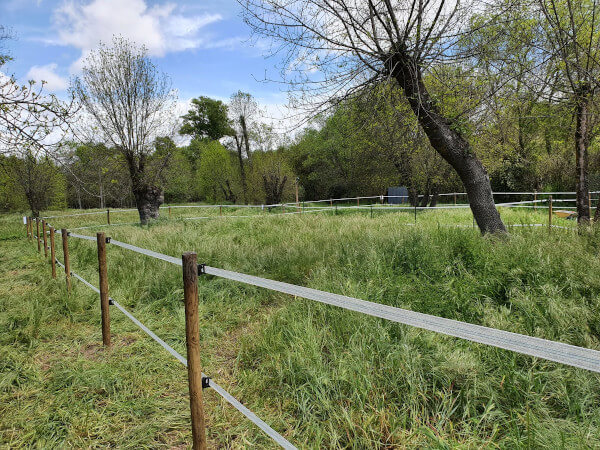It is safe to say that the advent of electric fences for horses was a turning point for fencing systems. Its main advantages are: low cost, versatility, perfect visibility, minimum risk for the animal and great mobility. If it isvisual, mental and physical barrierbarrera visual, mental y física for the horse.
Horses are whimsical creatures when selecting the grass they eat and, often, they make uneven use of their fields or paddocks. Certain areas of the fields may be overused, to the point of ruining the crops, while others may remain untouched. This system’s mobility allows us to move the fencing at will to address this bad habit and make the most of every field.
Electric fencing has yet another important feature: the respect it instils in horses, which prevents their tendency to lean on fences, scratch themselves against them or even chew them, habits which obviously end up weakening or damaging the whole fencing system.
Essentially, electric fences consist of a series of posts or stakes which are driven into the floor and are equipped with insulators that support conductors of electric impulses which form the fence itself. These conductors come in four different types: wire, twine, cord and tape, with different measures and qualities within each type.
 Wireis very dangerous and, therefore, totally inadvisable for horses. Nylon twine (3 mm),for its part, is difficult to see and LUPA only recommends its use as backup and protection of other fences.Cord (6 mm) is extremely useful in very windy areas, since it offers less resistance to air than tape, though its visibility must be highlighted so that horses respect it.Ruban tape is the most advisable solution, though not all tapes for electric fencing are the same. They come with different wire widths and different tape patterns, i.e. with different degrees of resistance.
Wireis very dangerous and, therefore, totally inadvisable for horses. Nylon twine (3 mm),for its part, is difficult to see and LUPA only recommends its use as backup and protection of other fences.Cord (6 mm) is extremely useful in very windy areas, since it offers less resistance to air than tape, though its visibility must be highlighted so that horses respect it.Ruban tape is the most advisable solution, though not all tapes for electric fencing are the same. They come with different wire widths and different tape patterns, i.e. with different degrees of resistance.
It is important to note that horses are not very sharp sighted. They can see in a 350-degree angle, but only about 65 degrees with both eyes at the same time. They have a poor blurry sight, bad perspective and two “blind spots”: in front of their noses and behind their bodies. Also, they are colour blind, so they can only distinguish different tones of grey, although recent studies about the most visible colours for horses, show that these seem to be brown and green. Apart from mere appearance, this is the reason why tapes come in different colours: white, green, brown… White tape has the added benefit of enabling us to check the fence from a distance and ensure it is in good condition.
Successful electric fencing relies on a good choice of materials, their appropriate installation and an adequate maintenance. An electric fence requires a powerful energizer, and must be well insulated and equipped with a good earth spike. Energizers can be mains-powered, battery-powered or solar-powered.
As with other fences, the use of two tapes is the normal approach, though three is even better, especially if there are very young horses or ponies. The first time you use an electric fence, take the horse near enough for it to receive a brief electric shock. Later, when free, the animal’s natural curiosity will make it try again. The horse will then receive a second shock which will show him/her to respect the fencing forever. On the other hand, if you turn the horses loose with no prior teaching, they may run into the fence while playing and, though they will receive a shock, it will be too late.
In our store, you will find a wide range of electric fencing products. If you need more personalized advice, please tell us what type of horses you will keep in the enclosure, the purpose of the field, as well as its size and access to an electric power supply. You can send it all through our contact form.